.

Apples on a tree, orchard in Delta County, Colorado: photo by Russell Lee, September 1940
Season of mists and mellow fruitfulness,
...Close bosom-friend of the maturing sun;
Conspiring with him how to load and bless
...With fruit the vines that round the thatch-eves run;
To bend with apples the moss’d cottage-trees,
...And fill all fruit with ripeness to the core;
......To swell the gourd, and plump the hazel shells
With a sweet kernel; to set budding more,
...And still more, later flowers for the bees,
...Until they think warm days will never cease,
......For Summer has o’er-brimm’d their clammy cells.
..............................
Who hath not seen thee oft amid thy store?
...Sometimes whoever seeks abroad may find
Thee sitting careless on a granary floor,
...Thy hair soft-lifted by the winnowing wind;
Or on a half-reap’d furrow sound asleep,
...Drows’d with the fume of poppies, while thy hook
......Spares the next swath and all its twined flowers:
And sometimes like a gleaner thou dost keep
...Steady thy laden head across a brook;
...Or by a cyder-press, with patient look,
......Thou watchest the last oozings hours by hours.
..............................
...Where are the songs of Spring? Ay, where are they?
...Think not of them, thou hast thy music too,—
While barred clouds bloom the soft-dying day,
...And touch the stubble plains with rosy hue;
Then in a wailful choir the small gnats mourn
...Among the river sallows, borne aloft
...Or sinking as the light wind lives or dies;
And full-grown lambs loud bleat from hilly bourn;
...Hedge-crickets sing; and now with treble soft
...The red-breast whistles from a garden-croft;
......And gathering swallows twitter in the skies.
John Keats (1795-1821): To Autumn, 19 September 1819, from Lamia, Isabella, The Eve of St. Agnes, and Other Poems, 1820

Exhibit of crops and vegetables at the Pie Town, New Mexico Fair: photo by Russell Lee, October 1940
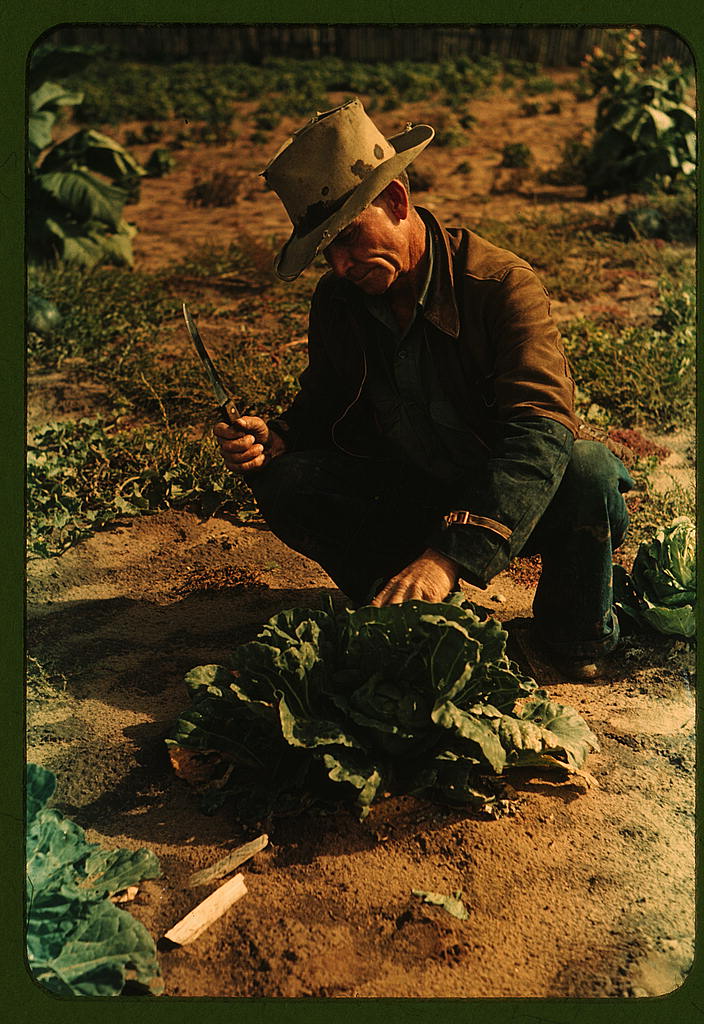
Jim Norris, homesteader, cutting a head of cabbage, Pie Town, New Mexico: photo by Russell Lee, October 1940
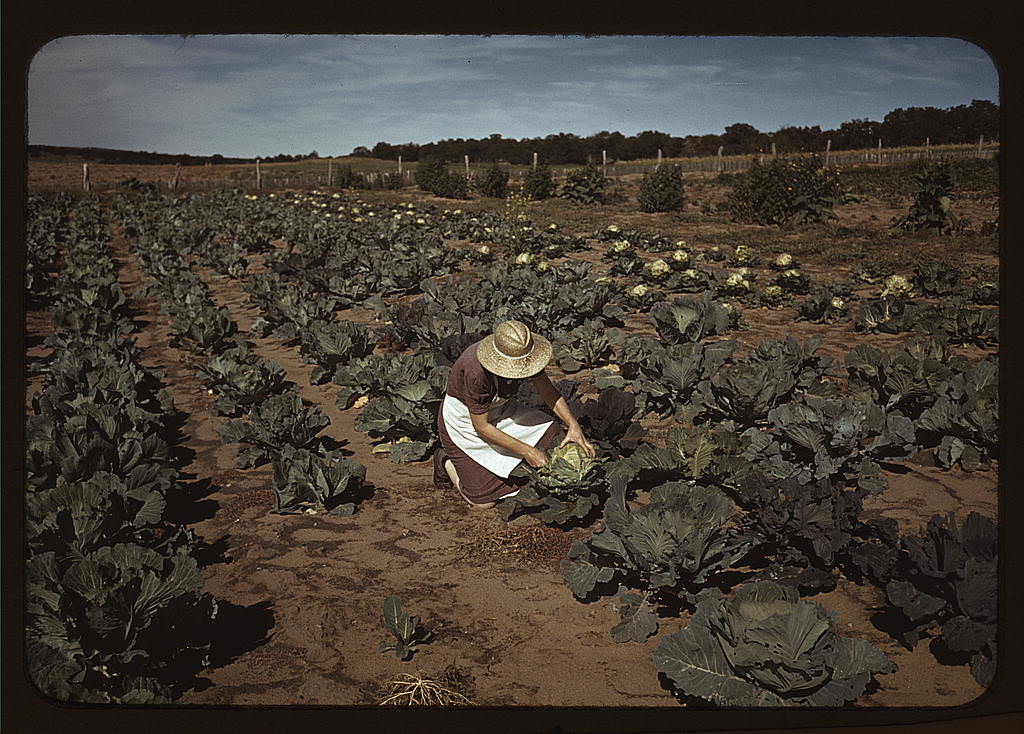
Mrs. Jim Norris with homegrown cabbage, one of the many vegetables which the homesteaders grow in abundance, Pie Town, New Mexico: photo by Russell Lee, October 1940
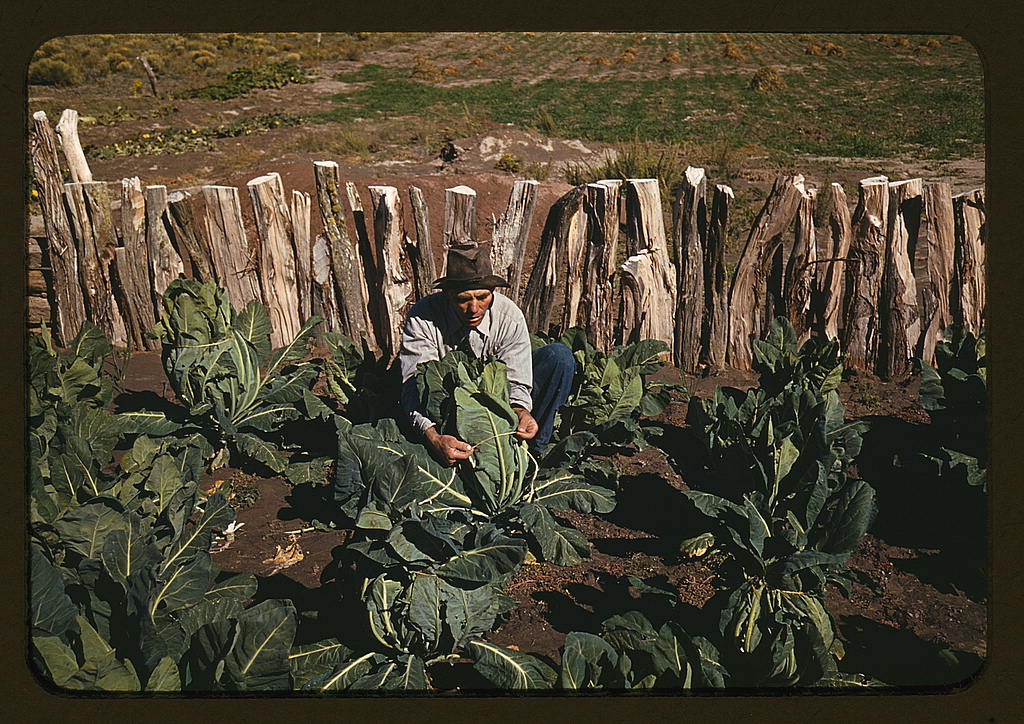
Mr. Leatherman, homesteader, tying up cauliflower, Pie Town, New Mexico: photo by Russell Lee, October 1940
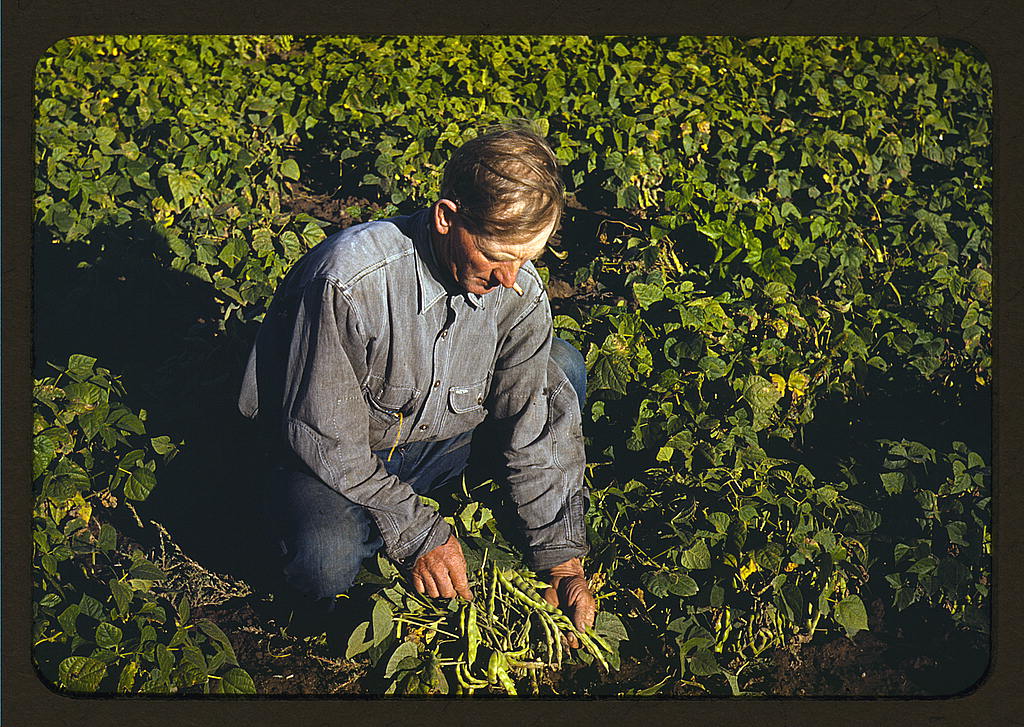
Bill Stagg turning up his beans, Pie Town, New Mexico. He will next pile them for curing: photo by Russell Lee, October 1940

Harvesting corn, Pie Town, New Mexico: photo by Russell Lee, October 1940
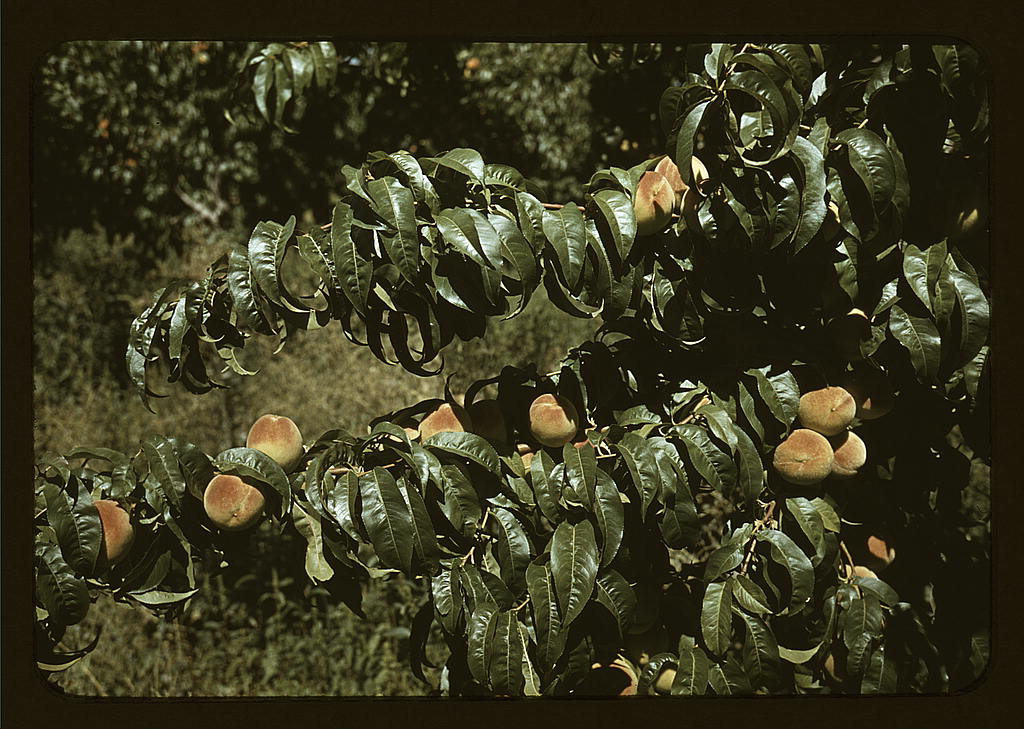
Peach tree in an orchard, Delta County, Colorado: photo by Russell Lee, September 1940
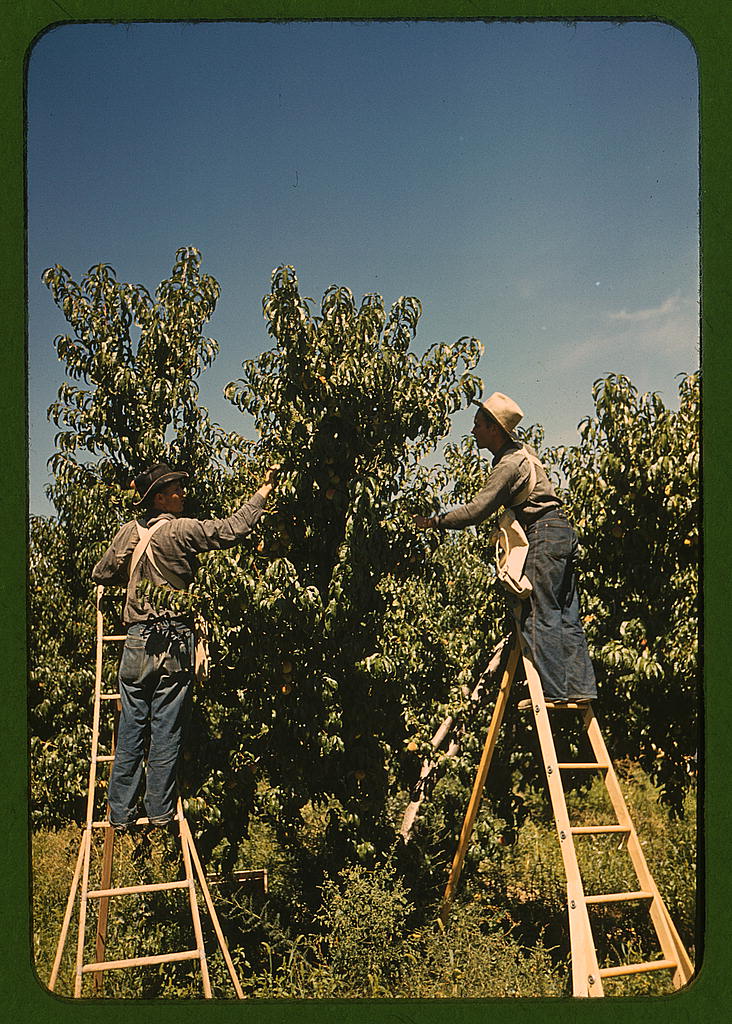
Pickers in a peach orchard, Delta County, Colorado: photo by Russell Lee, September 1940 x
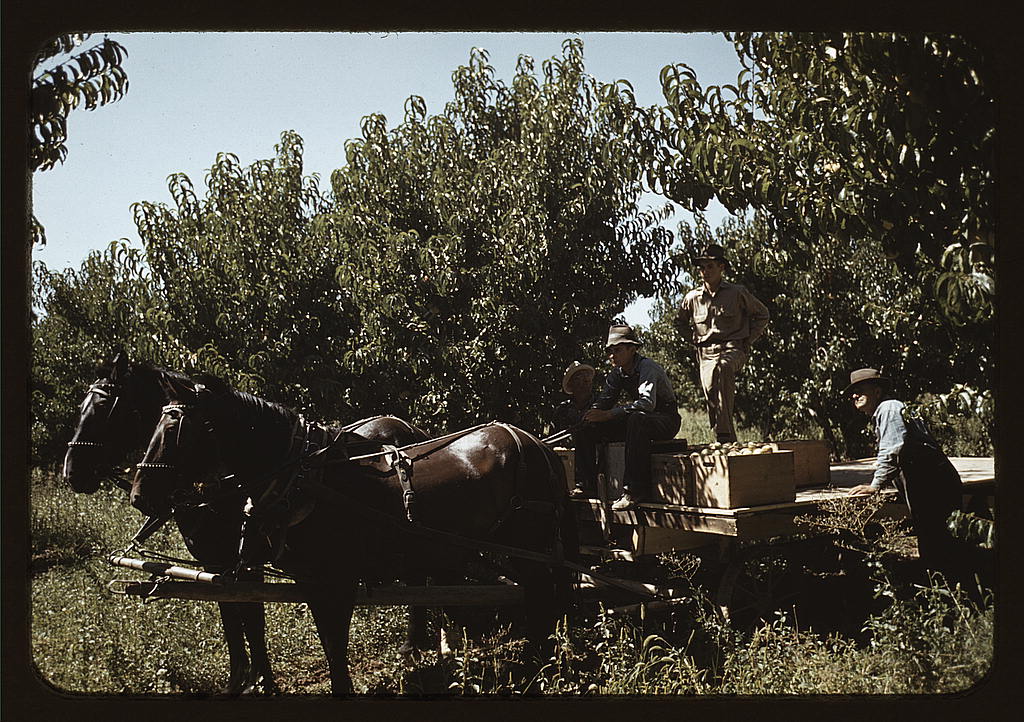
Crates of peaches being gathered from pickers to be hauled to the shipping shed, Delta County, Colorado: photo by Russell Lee, September 1940 x

Hauling crates of peaches from the peach orchard to the shipping shed, Delta County, Colorado: photo by Russell Lee, September 1940
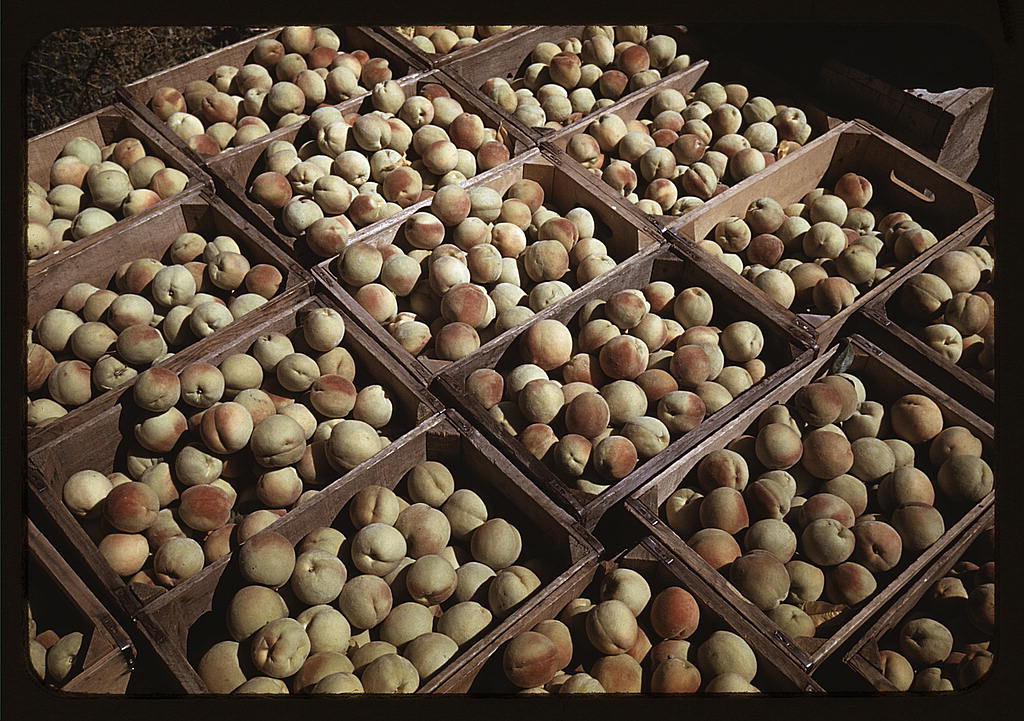
Crates of peaches in the orchard, Delta County, Colorado: photo by Russell Lee, September 1940

Hay stack and automobiles of peach pickers, Delta County, Colorado: photo by Russell Lee, September 1940
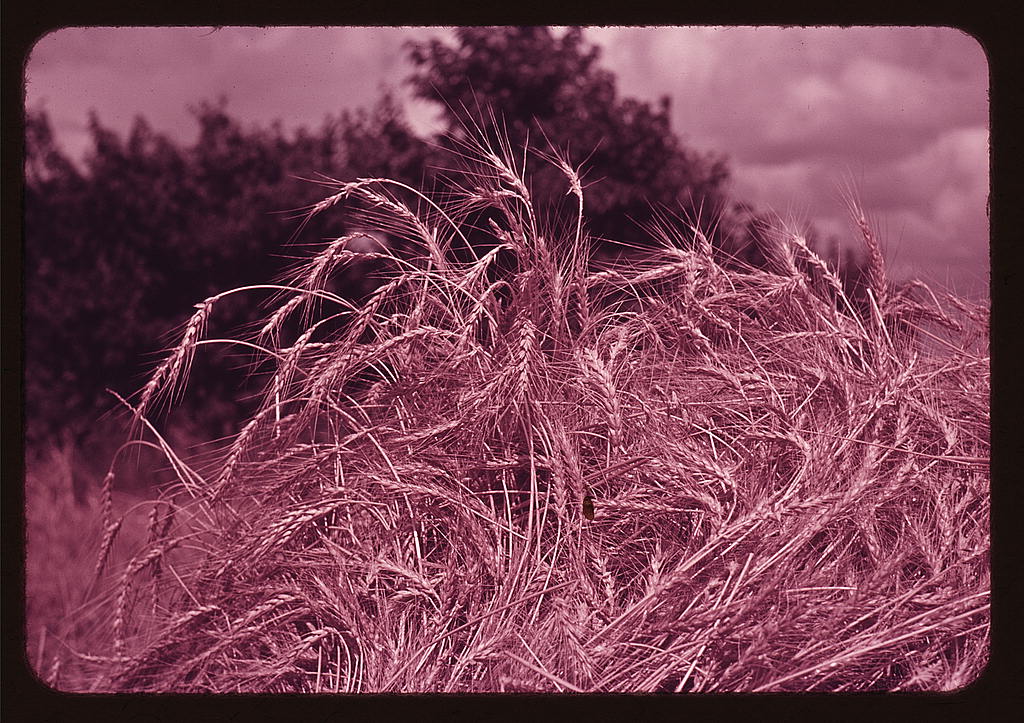
Wheat near Muskogee, Oklahoma: photo by Russell Lee, September 1939 or 1940

Corn near Muskogee, Oklahoma: photo by Russell Lee, September 1939 or 1940
It's surprisingly difficult photographing fruit on trees; I know because I was doing it yesterday, though not as successfully as here - what beautiful pictures. I love the guy on the wooden sledge, I wonder whether he was an ex-Norwegian.
ReplyDeletePietown? Language marks times changing, I can't imagine a Pietown today. It's certainly not self-aggrandising or pompous, so it wasn't thought up by a developer.
Artur.
All this beauty, Tom, and sadness and wonder and yet I am uncharacteristically struck by the humans here. The quality of Lee's work gives separate individual life to everything, the inanimate, even man. The texture really parallels the poem ... the tone of both, if you will.
ReplyDeleteDon
The more I look, Tom, it's the light. It captures the humans as of the earth, earth itself, as Watts was fond of saying, we come out of the earth not into it.
ReplyDeleteHere is proof positive ... for those such as I who hide so much under the bed.
Don
Nothing beats a slice of hot apple pie a la mode
ReplyDeleteand a cup of black coffee at The Pie Town Cafe
(or what-ever that diner was called)
nothing !
well maybe their hot peach pie with a scoop of REAL vanilla ice-cream ?
Pie Town is a tiny dot on the map, way up in the northwestern corner of New Mexico, atop the Continental Divide and a long way from anything resembling a big city. It remains sparsely inhabited, legally unincorporated, and, by all accounts, happy to be that way. An enterprising pie-o-neer named Clyde Norman established a dried-apple business there in the early 1920s, thus the name. To this day the pie's the thing in Pie Town, which proudly claims the best pies in the universe.
ReplyDeleteWhen Russell Lee drove into Pie Town at harvest season in 1940 he found a community of homesteaders making a brave go of producing a living for their families out of the fruits of a high, dry land that must have seemed quite challenging; especially so, given the background of a photographer who hailed from a part of the country (rural Illinois) where the soil is deeper, richer and altogether more amenable to subsistence farming. I believe Lee recognized the courage and make-do spirit of the people immediately. And the perseverance and commitment of these hard-working tenders of the soil, coaxing rich fruits from dry country, must have seemed to him in many ways representative of the larger spirit of social and economic recovery which it had always been the mission of the FSA photographers to document. At any rate, he came to town, looked about, mingled with the locals, took the time to understand, and with his camera preserved in a very wonderful way the struggle and dedication of the people of this tiny settlement at the edge of nowhere. His portfolio remains one of the most remarkable instances of a truly well-realized cultural memory in a nation that lately seems intent on forgetting everything that was once admirable in itself. And perhaps foremost among the losses in this general forgetting is everything once signified by the word "common".
Some but by no means all of the FSA photographers came into that work with significant experience in the medium. (Lange, Evans, Rothstein, Shahn, Siegel, the most prominent examples.) Others discovered the art on the fly; among these were several of the very best. John Vachon was a young filing clerk drafted into picture-taking. Jack Delano was a musician. Russell Lee had been trained as a painter. The lovely sense of composition and the extraordinary warmth of light in Lee's work attest to that background. Above all, though, I can't help thinking it was his genius at comprehending the abiding qualities of character in people -- working people in particular, but also people in general -- that makes Lee's work so distinctive. There is a "natural", unforced, unposed feel to his pictures that seems unarguable evidence of his ability to win the respect and trust of those in whose company he found himself. For all the wonders of their work, I've always sensed that with Walker Evans and Dorothea Lange, to name perhaps the two most eminent of the FSA photographers, there is a looking beyond the immediate subject to some greater historical "meaning", achieved, often, by "setting-up" or "staging" a shot. With Lee that kind of calculated distance from the "subject" seems not to exist.
In consideration of the good comments here, a few further thoughts...
ReplyDeleteDon, I think you've hit on the key to what I have been struggling to say. Even in Russell Lee's images of inanimate things, the products of human activity, it is a sympathetic recognition of the human investment of care that always opens up a scene, illuminates and lends a tone of living warmth.
Keats' magnificent poem has no people in it, so in this post I've deliberately shown very little of the population of this little American frontier town. But I feel like I've been there before with Russell Lee, and on the earlier occasion I've tried to represent his images of the Pie Town homesteaders themselves, on the occasion of their celebration of the hard-earned fruits of their toil at the Pie Town Fair.
While speaking of photographers and the fruits of the earth, let me not forget the mouth-watering delights provided just now by our friend Artur of A Bad Guide, who lovingly tends his orchards in a private pie town among the fjords, and manifestly knows whereof he speaks. "Thou watchest the last oozings hours by hours..."
(Our own old resident plum tree, meanwhile, not unlike this blogger, has seen better days; it provided us with nearly three decades' worth of pies, but the endless cold season of this summer-less year seems to have nipped its last buds, and alas, no fruit...)
Looking again at Artur's drool-inducing fruits I am reminded Keats was a great lover of sweets -- Yeats once rather snootily if not completely unfairly likened him to a small boy with his nose pressed against the glass of a sweet-shop window.
ReplyDeleteIf you click for enlargement, you will find, at bottom-center, in one of my "Deep Keats Scrolls," his remarkable paean to a beatified strawberry.
(This is not to say it is so terribly difficult to induce drool in the agéd, but still.)
Our plum trees sometimes take a year off, especially following a very abundant year. How many fruit we get depends on more than the weather and the bees. We've got other self-pollinating trees that haven't yet produced any fruit. It's all a bit of a mystery.
ReplyDeleteArtur.
Yes, Artur, orchards do prefer a warm situation.
ReplyDeleteAnd from what we can make out at this distance, it appears the late summer/early fall of 1819 in the southwest of England was fruitfully temperate.
(As indeed it was, at this time of year in 1966, when I went there -- in search of, I suppose I ought to say, Keats's cyder-press... at that time, coincidentally, the "pirate" pop stations were full of that curious period classic, "Winchester Cathedral".)
Tom,
ReplyDeleteLook at all I've missed here, these last few days, having been up in the mountains at 10,000 feet (Tioga Pass) with Johnny -- thunder showers, new snow on peaks, cold nights (20 degrees?), but then clearing on Saturday, and look now here -- no fog!
Thanks for all this. . . .
This is one of my favorite poems, just as autumn is a favorite season, bringing memories of long ago. Corn in the crib, oats in the bin, alfalfa in the hay mow, fruit and vegetables in the larder, hay stacks ready for the first snow, and shocked cane standing in the field.
ReplyDeleteThank you, Tom, for all of these wonderful posts today!
Steve,
ReplyDeleteGreat that you and Johnny had a chance to experience together the change of climates and seasons, from mountains to ocean, from summer into Fall... (cooler nights here now, too).
Marcia,
Well, as you know, farming, especially dry-land farming, was no easy existence at the best of times. But being able to grow what you eat, and to see what it is before you eat it, what a gift, what a blessing, even with (or maybe all the more because of) all that hard work.
I didn't read the poem yet. I only looked at the photos. It is starnge to see color in a time that, to me, is black and white. It makes it real in a way that I am sure the current generation will not fully understand because there is color and moving documentation of everything they have done and their parents ahve done and their grandparents have done. But the black and white history I grew up with is elusive to me and when that is shattered by color or rare movies, it feels like time travel. I love it. It makes me feel connected to the past and other humans who are probably long dead in a way I am not yet capable of articulating. Than you for this blog, Tom.
ReplyDelete"fadsorim"
Robb,
ReplyDeleteRare indeed the almost supernatural quality of presence in these photos, the warmth and saturation of light with color, everything shot-through with living-ness. Feels almost more present than historic. We "remember" the past in black and white -- these photos come from the time when I was born, yet all the family photos from those times are black and white. I had come to "remember" the past in black and white, in later years. Color is a shock of presence.
I think Eastman Kodachrome has something to do with it.
And this photographer, Russell Lee, had been trained as a painter.
an infinite amount of gradations in my black-and-white memories aussi
ReplyDeletea Gradation of the Mind through the View-Finder of a Brownie Hawkeye
those early color photographs seem 'other-worldly' and a bit 'washed out' to my eyes...
Film Noir in color? NAW; is not natch.
from the heart/mind
to the hand
to the page
is still & black
on white
besides
color film is so damn expensive
and very expensive to process / experiment
with in your own
closet dark room
watch the image come up
via the magic of that liquid through !
one learns
to watch and wait
the initial 'click' is just the
beginning
This just blew my mind:
ReplyDeletehttp://www.howtobearetronaut.com/2011/04/inside-the-hindenburg-in-colour/
"sphoot"
Ah, to be vapourized in full washed-out colour, while resting comfortably in one's Bauhaus stainless-steel chair...
ReplyDeleteMakes it all so much more (un)real, somehow.